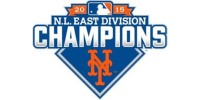David Wright
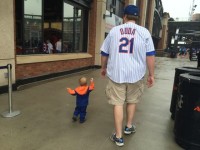
Last night, my son wanted to watch baseball. Fortunately, YouTube has about every game you could want to watch. For various reasons, I picked Game Three of the 2015 World Series.
What was interesting is that I never saw the telecast because I was at the game. It would not only be the first time I watched the game on TV, it would also be the first time I got to watch it with my son. From what my wife told me, he loved that game. It was great to watch it with him.
My favorite moment wasn’t him celebrating the David Wright or Curtis Granderson homeruns. It wasn’t even his the game inspired him to take out his teeball set. Surprisingly, it wasn’t even when he hit a line drive clear across the living room with him screaming “HOMERUN!” No, it was sinpler than that. It was when Lucas Duda came to bat.
My son looked up at the TV, waived and said, “Hi Duda!”
When I confirmed it was Duda by waving and saying hi to him as well, my son began saying hi to the players he remembered. At one point, I got him to scream:
I was impressed when he recognized Michael Conforto (his new favorite player) and told me he played leftfield. When I called over to my wife to let her know, her response was, “Of course he knows, you’ve been drilling it into his head.”
In any event, on what was a beautiful Spring-like day, I was never more prepared for baseball. My son is prepared too. Hopefully, he will get the chance to say, “Hi Duda” to him at Citi Field this year.
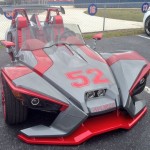
Overall, it’s hard to imagine a scenario where Yoenis Cespedes‘ 2016 season isn’t a disappointment. He’s expected to break Barry Bonds (or Roger Maris‘) single season homerun record, Hack Wilson‘s single season RBI record, and find a cure for cancer. Yes, this is hyperbole, but it’s really not that far from what’s being expected of him.
After his incredible run last year, Cespedes has set the bar sky high. When he came to the Mets, he played the best baseball of his life. It was some of the best baseball anyone has ever seen. More than anything, this has been the reason why he’s had all the attention surrounding him. If Tim Teufel had these cars, it would be an amusing antidote, but it wouldn’t be the focus of each and every day this Spring.
Look, the Cespedes’ car thing has been terrific. It’s added some fun to Spring Training. We’re talking about this instead of Terry Collins leaving in Matt Harvey, David Wright‘s back, Jacob deGrom tweaking his groin, Alejandro De Aza‘s possible discontent, or Roger Bernadina having visa issues. No, the Mets are having a fun camp in large part due to Cespedes.
That’s is unless you’re John Harper of the Daily News:
Just as Mets fans were quick to turn on Harvey during the innings-limit controversy last season, citing his look-at-me tendencies, they’ll tire quickly of hearing about Cespedes’ lifestyle if he doesn’t put up big numbers.
Same goes for the clubhouse. Teammates will gladly accept Stsr behavior as long as it comes with star performance. And certainly Cespedes has earned plenty of slack in this area, having astonished his fellow Mets with his offensive exploits last summer after coming over from the Tigers on July 31.
Why are we preemptively chastising Cespedes? Keep in mind, this is the same writer that despite knowing all of the “issues” Cespedes presents, he implored the Mets to re-sign him. Now that he’s here, what’s the point of tearing him down?
Cespedes was everything the Mets thought he would be and more last year. So far, he has been everything we thought he would be this Spring Training. It makes sense that the guy with the neon yellow arm sleeve and the 52 medallion would have an epic car collection. It makes more sense that Cespedes was going to be the focal point of this team no matter what he did. Why not have some fun along the way?
Look, his season is bound to be a disappointment. His 162 game averages are “only” 30 homeruns and 103 RBI. That’s not going to be enough for some people. That’s a shame because fans wanted Cespedes here, and he wanted to be here. No matter what Cespedes does this season that should be celebrated. Instead, the Daily News is already finding ways to tear him down.
These preemptive attacks should be driven off a cliff.
Editor’s Note: this column first appeared on metsmerizedonline.com
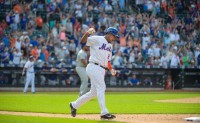
There is one thing you, me, and Juan Uribe have in common. We all love baseball. It was one of several great things we learned during the fun run that Uribe’s short tenure was with the Mets.
Back when the Mets first acquired Uribe, it was the first real sign of hope that the Mets could actually make the postseason. While we all knew the Mets had the pitching, injuries and ineffectiveness troubled the Mets offense. We never knew if or when David Wright was going to return. With Uribe, the Mets obtained a credible major league third baseman. His impact was felt almost immediately:
It was a fun run with Uribe. We learned he hated football, but he loved listening to the Backstreet Boys. He was fun to watch. He appeared to be a leader in the clubhouse. It’s easy to forget now, but if all the people in last year’s roster, he was the only one who had won a World Series. He was only one of two who ever played in the World Series (Curtis Granderson).
Overall, Uribe was more important than his .219/.301/.430 batting line. He was more important than his six homers and 20 RBI. Uribe was important because he provided the Mets with a credible third baseman. Uribe was important because he was the first sign that the Mets were ready, willing, and able to go for it in 2015. Uribe was important because he was great in the clubhouse.
A late season injury robbed him of much of his chance to contribute in the postseason. He did work his way back, made the World Series roster, and got to contribute with an RBI pinch hit single in the lone game the Mets won in the World Series.
Uribe brought an energy to the team. He was a joy to watch. He left an impact on the team. He left an impact on the fans. We were all better off for Uribe’s three months in a Mets uniform.
He’s now joining a Cleveland Indians team that’s very similar to what the 2015 Mets once were. I would not be surprised if the Indians had a good year next year. I’d be shocked if Uribe wasn’t a big part of that.
I’m going to miss Juan Uribe. He’s a big reason why the Mets are back . . . ALRIGHT!
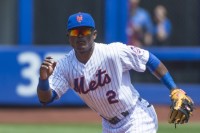
After the Mets make a decision at catcher, the team appears like they will have between $82 – $96 million to build a roster and re-sign their pitching.
Looking at the roster, the Mets will need to obtain starters at the following positions: 1B, 2B, SS, and RF. David Wright is scheduled to make $15 million, so whether or not you believe he will be able to stay at the position, he will remain with the team in some capacity. Michael Conforto should still be with the team as the leftfielder. Finally, unless the Mets can move him, Juan Lagares and his $9 million salary will be the team’s centerfielder. The Mets organization is fairly well stocked with position players right now, and they might be able to fill out the roster with cheap, cost-controlled talent.
First Base
Somewhat controversely, Keith Law named Dominic Smith the 29th best prospect in all of baseball. He’s the first baseman of the future.
Accordingly to the scouting reports, Smith is a good defensive first baseman that should be able to hit. The debate really is whether he will hit for power. Whether or not he hits for power, people see him as being able to field the position and be a good major league hitter.
With Lucas Duda being a free agent in 2018, the Mets will need Smith to be ready. If he’s not ready, the Mets will need a stopgap. In either event, by the time the Mets pitchers start to become free agents, Smith should be the first baseman earning around $500,000.
Second Base
We have to assume that one of these years Dilson Herrera is going to transition from second baseman of the future to the Mets second baseman. With Neil Walker only having one year until free agency, it appears that time will be 2017.
Right now, Herrera has less than one year’s service time. For all the supposed newfound depth, it’ll probably be Matt Reynolds getting called up to the Mets. That will preserve his service time. It means that in 2019, Herrera should be the second baseman, and he will have accrued two full years service time. Unless he gets enough playing time, it appears like he will avoid Super Two status meaning he will be in the same $500 – $600 thousand range as Smith.
Shortstop
As far as organizational depth, the Mets seemingly have an embarassment of riches with two high end shortstop prospects with Gavin Cecchini and Amed Rosario. They also have the aforementioned Reynolds.
Given Asdrubal Cabrera‘s contract, Cecchini and Rosario are going to have time to develop on the minors. At a minimum, Cabrera is signed to be the Mets shortstop through the 2017 season. If he produces well, or the prospects need another year, Cabrera has an option that could keep him with the Mets through the 2018 season.
As such, neither Cecchini or Rosario will be arbitration eligible at the time the Mets pitchers start to reach free agency. Accordingly, the Mets will only have to spend around $500 thousand when the pitchers begin to become free agents.
Left Field
It seems Michael Conforto is the leftfielder of the past (2015), present, and future. He very well should be too. Even if Conforto doesn’t improve upon his 162 game averages he achieved as a 22 year old, who never played above AA, you’re getting a good defensive outfielder who will hit .270/.335/.506 with 26 homers and 75 RBI.
Fortunately, Conforto will not have accrued enough service time to achieve Super Two status. Unfortunately, Conforto will most likely become arbitration eligible the same time that the Mets pitchers are reaching free agency.
Looking over the past few years, there isn’t really a good comparable to Conforto. It seems that when teams have good young corner outfielders, they lock them up. With that in mind, although an admittedly imperfect comparison, J.D. Martinez is instructive.
In 2014, Martinez was 26 years old, and he hit .325/.358/.553 with 23 homers and 76 RBI in 123 games. He became arbitration eligible after this season, and he agreed to $3 million. In 2015, he had another good year hitting .282/.344/.535 with 38 homeruns and 102 RBI. He and the Tigers avoided an arbitration hearing. Martinez’s contract extension bought out the remainder of his arbitration years he’s due to make $6.75 million in 2016 and $11.75 million in 2017.
While we may or may not agree on whether Martinez is a good comparable, it would be fair to say Conforto is at least capable of hitting .272/.344/.535 by his age 25 season, if not sooner. If that’s the case, it would be fair to suggest Conforto could earn anywhere from $3 – $6 million in his first year of eligibility.
Right Field
Curtis Granderson‘s contract will expire after the 2017 season. Since he will be 37 heading into the 2018 season, it’s hard to imagine he will be re-signed to be the everyday right fielder.
Now, Wuilmer Becerra projects to be an everyday player. Scouts believe he has the bat to play the corner outfield spot. The issue as far as the Mets are concerned is how quickly the 21 year old minor leaguer will need before fulfilling that promise. Last year, Becerra played his first year in full season A ball. That’s a long trek to the majors by 2019.
So unless Brandon Nimmo can handle the corner outfield offensively, which unfortunately seems unlikely, the Mets will have to look outside the organization to fill that void.
If Becerra is still a well regarded prospect, the Mets are likely to bring in a player on a one to two year deal. In retrospect, depending on how he finishes out his contract, Granderson could be coaxed back on a one-year deal ata much lower contract price.
As a placeholder, let’s presume the cost of a right fielder would cost about $15 million. That’s what Granderson is slated to earn the last year of his contract.
Cost of the Projected 2019 Starting Lineup
If everything breaks right for the Mets, they will have a group of young, cost-controlled position players at the time their starting pitchers hit the free agent market. If this pans out, the Mets everyday position players would cost about $46.5 million.
That’s roughly what the Mets are paying their current starting infield. In total, the 2016 Mets starting lineup is due to be paid roughly $90 million. Essentially, the Mets will be spending half the amount of money on their starting lineup in 2019 than they will this season.
Overall, this leaves the Mets between $35.5 – $49.5 million to build a bench, a bullpen, and to pay their starting rotation if the payroll remains stagnant at the $140 million range.
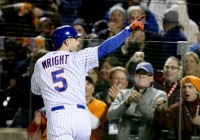
When David Wright came up in 2004, we thought every year was going to be like last year. Much like this year, we anticipated that each and every year Wright manned third base, the Mets would contend for a World Series.
As we know, it didn’t happen that way. A lot went wrong. The Mets came ever so close in 2006. They collapsed in 2007 and 2008. A poorly designed outfield, poor personnel decisions, and financial crisis ensued. Then, as things began to turn around, Wright injured his hamstring. Then he was diagnosed with spinal stenosis. Last year was his first trip to the World Series. This year may be his last year as a key contributor on a World Series team.
It could also be Wright’s last year to build his Hall of Fame credentials.
Third base is the least represented position in the Hall of Fame. Accordingly, standards are high to enter the Hall of Fame as a third baseman. The average of 13 Hall of Famers at the position had a career WAR of 67.5, a WAR7 (best seven years combined) of 42.7, and a JAWS of 55.1. Looking at the stats, Wright falls short. His career WAR is 50.1. His WAR7 is 40.0. His JAWS is 45.1. For a player that Mets fans believed would be a Hall of Famer, he now has an uphill climb.
WAR7
Looking at theses factors, it’s presumably easiest for Wright to increase his WAR7. To do so, he would need to have one year where he accumulates 2.7 more WAR that his seventh best season. Here are his seven best WAR seasons:
- 2007 – 8.3
- 2012 – 7.0
- 2008 – 6.8
- 2013 – 5.9
- 2005 – 4.8
- 2006 – 4.1
- 2009 – 3.2
For Wright to put his WAR7 within range, he would need to have one more season that is 5.9 or better. Wright last did that in 2013. That year Wright only played on 112 games. He hit .307/.390/.514 with 18 homers and 58 RBI. His 156 OPS+ was the best of his career. In that season, Wright missed a significant amount of time with a strained hamstring. Sounds just like his April 2015 hamstring injury that wouldn’t heal.
The Mets are hopeful that Wright can play 130 games in 2016. Judging from Wright’s 2013 season, it is certainly possible that Wright can have a 5.9 season again. A better and much stronger Mets lineup will assist him in that task.
Cumulative WAR
Going into the 2016 season, Wright has a career WAR of 55.1, which is presumably 12.4 behind the 67.5 career WAR he would need to be enshrined in the Hall of Fame.
This is where things may get a little tricky for Wright’s chances. Don Mattingly had back problems, and his once promising Hall of Fame career was over at 34. Lenny Dykstra had spinal stenosis, and his career was over at 33. David Wright is entering his age 33 season. Based on other player’s careers, he’s near the end of his career. If Wright plays past his age 34 season, he will be in uncharted territory.
Naturally, it is safe to assume Wright will not have a 12.4 WAR season thereby cementing his Hall of Fame case. To do that, Wright would have to match Babe Ruth‘s 1927 season when he hit 60 homeruns. No, if Wright is going to accumulate the needed 12.4 WAR, he’s going to have to remain healthy and effective. He’s going to have to manage his spinal stenosis.
Wright is currently signed until 2020. There are $90 million reasons why Wright will do all he can to finish that contract.
Presuming Wright does do that, he has five more years left in his career. In order to attain the necessary 12.4 additional WAR, Wright will have to average a 2.5 WAR a year for those five seasons.
In 2014, Wright played 134 games, and he was a 2.7 WAR player. In that season, he hit .269/.324/.374 with eight homers and 63 RBI. If Wright manages his back, and his treatments are effective, seasons like this over the next five years are certainly attainable.
Other Criteria
As Wright’s peak is over, there really isn’t anything he can do to improve his JAWS. With that in mind, we need to look at other areas that would improve Wright’s Hall of Fame case.
Unfortunately, he will be unable to surpass Mike Schmidt‘s 548 homeruns or even reach the once magic number 500 homeruns. He won’t catch Chipper Jones‘ 1,623 RBI. He won’t catch Brooks Robinson‘s 16 Gold Gloves at third base. It does not appear Wright will reach 3,000 hits as he would need to average 250 hits over the next five years to reach that number. No, it seems like the only thing that will help Wright is the narrative.
The best thing going for Wright is the fact that he will most likely play his entire career as a Met. Aside from Tom Seaver, Wright is making a case as the best player to ever play for the Mets. Here are his Mets rankings:
- Games Played – Second (307 behind Ed Kranepool)
- Runs – First
- Hits – First
- Doubles – First
- Homeruns – Second (17 behind Darryl Strawberry)
- RBI – First
In addition, Wright’s 50.1 WAR with the Mets is the second most any player has accumulated with the Mets; the most accumulated by any Mets position player. Even with Mike Piazza‘s recent election to the Hall of Fame, it appears that Wright is the team’s best position player.
So overall, Wright still has a legitimate shot at the Hall of Fame. His name will be atop all the major offensive catergories. His WAR and other catergories will put him on the cusp of election. A strong 2016 will get him a lot closer to those goals.
Winning a World Series in 2016 can’t hurt either.
Editor’s Note: this article also appeared on metsmerizedonline.com
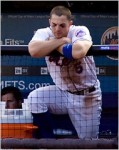
Today, the Mets officially report to Spring Training. With the 2016 season unofficially starting, David Wright begins his most important year as Captain of the New York Mets.
Back in 2007, Wright was a 24 year old superstar. His team was coming off a shocking loss in the NLCS, and yet going into 2007, many believed the Mets were the best team in the National League, if not all of baseball. With Wright and Jose Reyes, the Mets were seen not only as a win-now team, but also as a team that was built for the long haul. It worked out that way for exactly 145 games.
Not that Tom Glavine finds it devastating or anything, but the Mets collapsed over the final 17 games. There are a number of things we can point to as the reason the Mets collapses. Over those final 17 games, Brian Lawrence, a 23 year old Mike Pelfrey, and Philip Humber received starts with the Mets going 1-3 in those games. You can point to players like Reyes not hitting down the stretch. Speaking of Reyes, many point to him dancing in Game 161 as the reason.
After the Mets were swept by the Phillies, they had 14 games remaining against sub .500 teams. These teams had a combined .457 winning percentage. This includes a Cardinals team that had to come to New York to play a make-up game. They shut the Mets out. After the Phillies swept the Mets, there was every reason to believe the Mets would win the division, or at the absolute worst, the Wild Card. They did neither. There really is no excuse for what happened.
We saw it again in 2008. The Mets had a lead in the division up until the 149th game of the season. The Mets then lost the division lead. Again, the Mets season was on the line on the final game of the season. Again, they lost at home to a bad Marlins team.
Sure you can point to a myriad of things in 2008. Billy Wagner was injured leading to a revolving door at closer. Again, it’s excuses. The Mets had a different manager and pitching coach at the end of the season. Willie Randolph and Rick Peterson were the fall guys for 2007 in getting fired one game into a West Coast trip.
At the end of the day, it wasn’t the manager or the coaches. It was the team. There just was something missing. One player that wasn’t a problem? David Wright.
In 2007, Wright hit .352/.432/.602 with six homers and 20 RBI over the final month of the season. In 2008, Wright hit .340/.416/.577 with six homers and 21 RBI in the final month of the season. While Shea was burning, Wright was playing his best baseball. While there was a problem with those 2007-2008 teams, Wright wasn’t one of them.
Now, Wright is the only player that remains from those teams.
Wright is now 33 years old. He’s a leader on the team. He’s the Captain. Once again, he’s on a Mets team that has a chance to return to the postseason. He’s once again playing for a team that is a legitimate World Series contender.
This may be Wright’s most important season as the Captain. He can share with the team all the things that went wrong in 2007 and 2008 to help prevent any of these issues arising with this Mets team. If problems do arise, he can help guide the team. He can share with them whatever it was within him in 2007 and 2008 to play his best when the team seemed to be at their worst.
In 1986, the Mets had a de facto team captain in Keith Hernandez that showed the team how to win. Thirty years later, the Mets have a Captain that can show the team how not to lose.
Hopefully, with another Mets captain leading the way, the Mets will once again win the World Series.
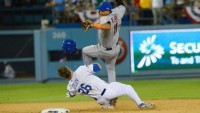
Next year, Chase Utley is going to be a utility player. He going to be a utility player because he’s 37 years old, and he has diminishing skills. He could retire, but he decided to hang around for another year or two. He’s not in this situation because someone injured him.
Last year, Ruben Tejada was not the starting shortstop on the Opening Day roster for the first time in his career. No, last year, the job was given to Wilmer Flores. Tejada was going to be a utility player to start the season. Then something strange happened. For all the years of the Mets just handing him the job, and him failing to hold onto it, Tejada finally rose to the challenge the year the job wasn’t just handed to him.
Last year, Flores had his offensive and defensive struggles. The Mets team was decimated by injuries. Tejada got some regular playing time. He then got some time at shortstop. He showed that while he had less range than Tejada, he had a steadier hand. More importantly, he began to hit:
- July .287/.330/.347
- August .235/.381/.294
- September .297/.357/.406
He entered the postseason as the Mets starting shortstop over Flores. He earned that right. Then with one dirty play Chase Utley took it all away. Tejada broke his leg. In the offseason, while he was hobbling around with a walking boot, the Mets signed Asdrubal Cabrera to take his place.
Utley reportedly reached out to David Wright to apologize to Tejada. He reportedly sent Tejada some things in the offseason. For his part, Tejada says all he wants is an apology.
Up until now, Utley has gone on and on about how he was playing hard and that he was playing the right way. However, his actions at least show remorse. The reason for this is he broke an unwritten rule, perhaps the most important rule amongst all players in all sports. You don’t injure other players with dirty, or even borderline plays. You don’t ruin another player’s career. Utley did that.
Utley took away Tejada’s job with one dirty play. Like Utley, Tejada is now a utility player. For what it’s worth, Tejada is not letting this hold him back:
I’m going to keep working hard, you never know what’s going to happen here. I want to stay focused all the time.
In 2015, Tejada was a utility player to start the season, and he finished the year as the starting shortstop. Utley put him back in that position this year. I’m not counting out Tejada this year, especially with dirty players like Utley out there.
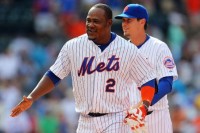
Families and friends will gather around the TV tonight to watch the Super Bowl tonight. Some gather for the game. Some gather for the commercials. With some Mets already at Spring Training, I’m sure they’ll get together to watch the game.
One person we know who will not be there is Juan Uribe. No, not because he’s a free agent. He’s not watching because he really hates football. He only wants to watch baseball. If he was there tonight, he’d probably tell David Wright to turn on the baseball game. Unfortunately for Uribe, there’s no baseball games being televised during the Super Bowl tomorrow. No, not even on the MLB Network.
So who knows? Maybe Uribe breaks down and watches the Super Bowl tonight. If it’ll help him to know that Cam Newton loves baseball or that his former teammate Todd Helton was a former teammate of Peyton Manning at Tennessee.
In any event, after tonight, it’s all about baseball just like Juan Uribe wants it to be.
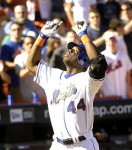
Today is the eighth anniversary of the Johan Santana trade. Over his tenure with the Mets, Santana pitched well to brilliantly when he was able to pitch.
Santana tried to will the Mets into the postseason in 2008. He pitched on three days rest on a bum knee and gave the Mets a brilliant outing, a complete game, three hit, nine strikeout, shut out. It would be the Mets last win at Shea Stadium. It would be his last great season, but not his last great moment. On June 1, 2012, he threw a 134 pitch no-hitter on a surgically repaired shoulder. The first in Mets history. It was effectively the end of his career.
The cost for all of this? Basically, it was Carlos Gomez. Yes, the same one. It’s interesting that it was Gomez because he wasn’t what the Twins initially wanted. They wanted Lastings Milledge.
At that time everyone wanted Milledge. The A’s wanted Milledge in exchange for Barry Zito. The Mets balked in 2006. They balked despite Pedro Martinez‘s injury problems. The Mets thought that highly of Milledge that they were willing to let him possibly stand in the way of a World Series title. He was considered that good. Except, unfortunately, he really wasn’t that good. His stock would go down to the point where he could only fetch Brian Schneider and Ryan Church. That’s a far cry from Barry Zito and Johan Santana.
The lesson here isn’t necessarily that you should always trade prospects. If that’s the case, the Mets wouldn’t have David Wright. No, the lesson is to make sure you are right before trading prospects.
The Mets were wrong about Gomez and Milledge. Most were. Now, Milledge is playing in Japan. Gomez is a two-time All Star. He’s a Gold Glove centerfielder. There are different times the Mets could’ve used him either as an outfielder (possibly avoiding the disastrous Jason Bay signing), or used him as a trade chip. Unfortunately, he wasn’t there because the Mets held onto the wrong prospect.
There are many lessons to learn with Santana, namely about abusing pitcher’s arms. The other lesson is that teams have to be right about their own prospects. By holding onto Milledge, the Mets might’ve lost out on a World Series in 2006. By being wrong about Milledge, the Mets lost out on Gomez’s career.
So whenever the Mets trade a prospect, we should look not just at the return, but also who they didn’t trade. As we saw with the Santana deal, you can still win a trade while still losing out on something else.
